Red Panda Identity
Encountering a red panda, one is struck by its distinctive bushy ringed tail and bright reddish-brown fur. This mammal’s identity is steeped in a mix of confusion with bears and raccoons, specialized physical traits, and a perilously shrinking habitat.
Taxonomy and Classification
The red panda, Ailurus fulgens, is a unique species part of the Ailuridae family. Though once thought to be related to raccoons or bears, molecular studies, including an immunological study, place it in its own family. They are not bears; instead, they occupy their own distinctive spot in the mammalian tree of life.
Physical Characteristics
Red pandas are small and nimble mammals, typically weighing 3 to 6.2 kg. Their most striking physical characteristics include reddish-brown fur, a bushy, ringed tail, and large pointed ears. They have a unique adaptation in their wrist bone; a ‘false thumb’ that helps them grip bamboo, their main food source.
Habitat and Distribution
These creatures are indigenous to the temperate forests of the Eastern Himalayas, dwelling in regions across Nepal, Bhutan, Northern India, and Southern China. Adapted to live in high altitudes, they are found from 2,200 to 4,800 meters above sea level, but deforestation is shrinking their living space rapidly.
Diet and Behavior

The dietary preferences of the red panda and their various behaviors provide insight into their unique ecological niche. They possess an unusual diet for a carnivore and exhibit fascinating behaviors that reflect their adaptation to their habitat.
Feeding Habits
Red pandas are primarily bamboo eaters, with bamboo shoots and leaves constituting a significant portion of their diet. However, this ‘herbivorous carnivore’ also supplements its diet with fruit, acorns, and even eggs when available. Their food consumption can fluctuate greatly, with studies noting changes tied to the energy demands of lactation. While mostly consuming bamboo, the red panda’s diet varies with the seasons, and they’re adapted to handle a wide range of food intake levels.
Reproduction and Lifespan
The reproductive season for red pandas is from January through March. During this time, females attract males with vocalizations and scent markings. After a gestation period typically around 134 days, females give birth to one to four cubs. Cubs stay with their mothers for about a year, which coincides with the next breeding season. Red pandas can live up to 15 years in the wild and may live longer in captivity due to medical care and lack of predators.
Social Structure and Communication
Red pandas are territorial animals with a complex social structure. They lead largely solitary lives, marking their territory with scent glands. Communication among red pandas occurs through various vocalizations and body language. When it comes to the arrangement of their society, it has been observed that red pandas exhibit selective feeding behavior, which can impact the way they interact with one another and share space within their habitat.
Conservation Efforts

The red panda, an endangered species often mistaken for a bear, faces a precarious future. There are numerous efforts underway to secure its survival, contemplating both the direct threats to their existence and the strategies to protect these adorable creatures.
Threats to Survival
Red pandas are teetering on the brink of extinction due to habitat loss, largely driven by deforestation for timber, fuel, and agricultural expansion. They also fall victim to poaching and illegal trade, sought after for their distinctive pelts and for pet trade, which exacerbates their decline. The IUCN lists the red panda as Endangered, indicating the high level of concern for its survival.
Protective Measures
To combat the numerous threats, conservation groups and governments are stepping up their efforts. The establishment of protected areas provides safe havens that are crucial for the ongoing survival of the species. Organizations like the Red Panda Network are actively engaged in monitoring populations and creating community-based conservation programs. These actions, along with legal protection against poaching and trade, form the cornerstone of current efforts to ensure red pandas can thrive for generations to come.

